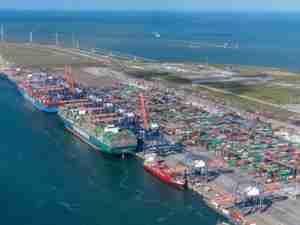From major retailers to trucking and shipping, the companies represented at the 45th annual GFTC, are making major strides in emissions control, reduced energy consumption and cost savings.
“American companies and ports are working together to reduce the environmental footprint of the transportation sector,” said Georgia Ports Authority Executive Director Curtis Foltz. “From building the first ever LNG-powered ships and electric-powered rubber-tired gantry cranes to improving truck move efficiency, reducing idling and employing cleaner burning fuels, the panel provided far-reaching examples of environmental sustainability.”
James Jack, executive director of the Coalition for Responsible Transportation (CRT), said “greening” the supply chain is a common theme.
“It’s no secret that shippers have begun to factor environmental performance into their supply chain decisions,” Jack said. “It goes without saying that ports like the GPA have also responded to this challenge. As we have seen, they have implemented a variety of different ways to address air and water quality challenges.”
TOTE President and CEO Anthony Chiarello said the steamship company has two 3,100-TEU container ships under construction to serve their East Coast to Puerto Rico trade. They will be the first containerships designed specifically to burn LNG fuel, Chiarello said. The company is also in the process of converting existing vessels on its Pacific Northwest to Anchorage, Alaska, route from heavy oil bunker fuel to liquefied natural gas (LNG).
Chiarello said point-to-point routes are the logical first step in LNG container ships because refueling stations are easier to establish. He added that while LNG offers approximately 40 percent cost savings, the major impetus was environmental stewardship. “When you can cut your sulfur burn by 99 percent vs. what it would be with bunker fuel, for us, it becomes a classic no-brainer,” he said.
Foltz said the GPA is also considering a move to LNG-fueled vehicles. “We operate 200-plus marine tractors every day inside the port complex,” Foltz said. “I would suspect in the next two to four years, the vast majority of those will be operating on an alternative fuel other than diesel. We believe that’s going to be either LNG or CNG (compressed natural gas).”
Panelists also discussed other major trends in sustainability, such as working with their contracted trucking companies to have them shift to newer, cleaner running trucks, as well as a greater emphasis on two-way truck moves.
Traditionally, trucks have carried loaded containers to distribution centers and empties back to the port. Now, however, retailers are working to fill those return boxes in two ways. The first is by partnering with nearby companies that need to move goods for export. Another method is to bundle wood and cardboard packaging, which is then shipped overseas to be recycled.
Rick Gabrielson, director of international transportation for Target, said the retailer instituted a “no-idle” policy for trucks at its distribution centers. Working closely with carriers, vendors and other partners, Target is transitioning to greener trucks, including test programs for hydrogen- and electric-powered vehicles. “Sustainability is really integrated throughout our business — from how we build our stores to our distribution centers and supply chain operations,” Gabrielson said.
He noted that a number of shippers are beginning to convert a portion of their truck fleets to natural gas, and Target is also moving that direction. He said cross-country routes are not yet possible because filling stations are sparse.
“Where you have one-day delivery for stores in the range of 50 to 100 miles, we’re beginning to see more and more interest in it and more organizations taking a look at it,” Gabrielson said. “Target is no different.”
GPA Board Chairman Robert Je










